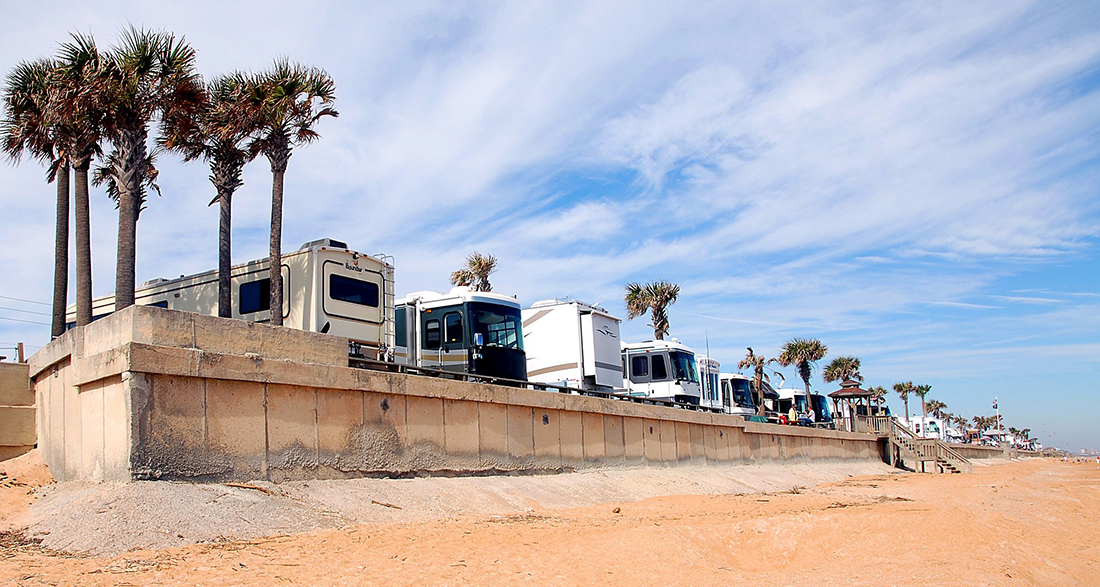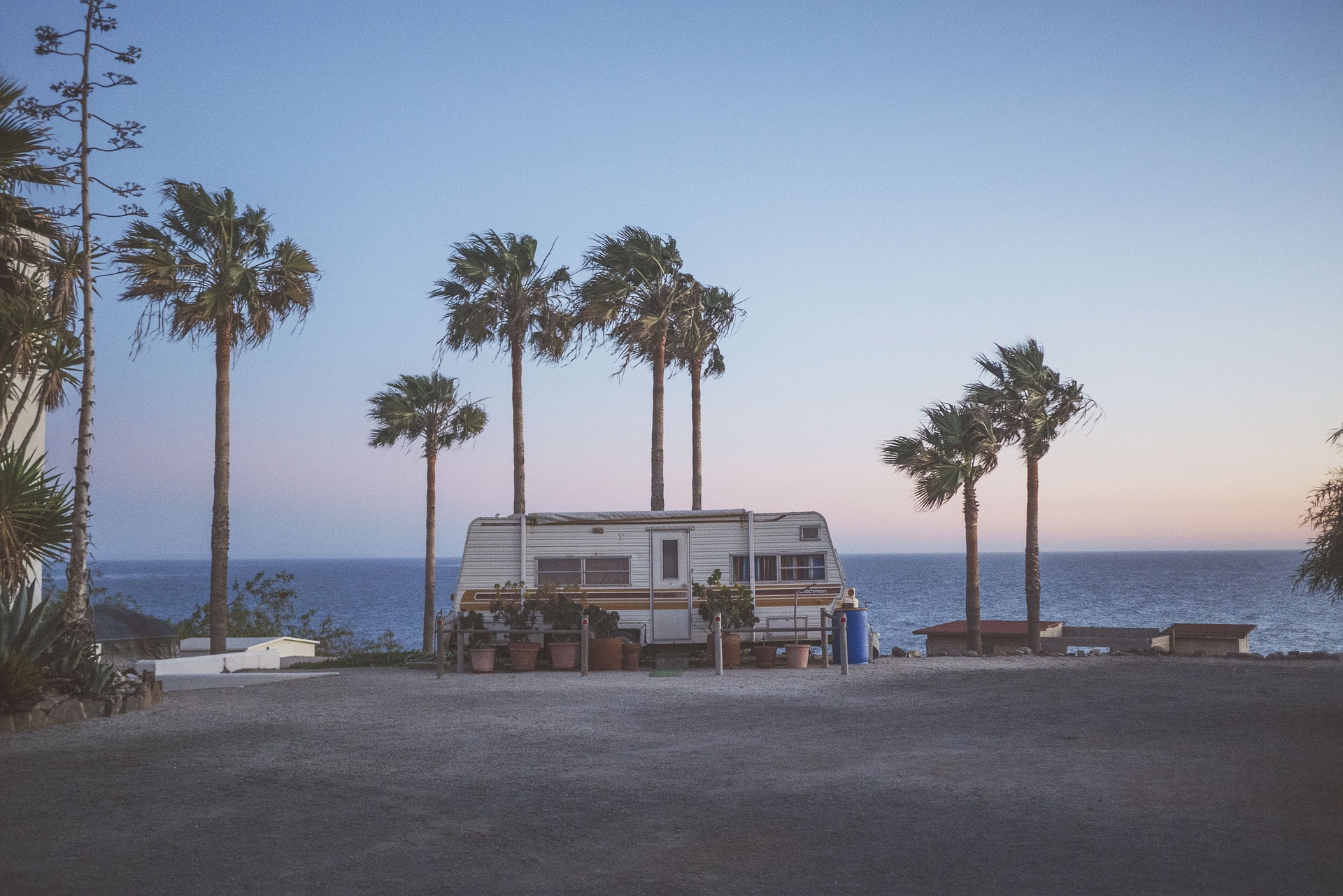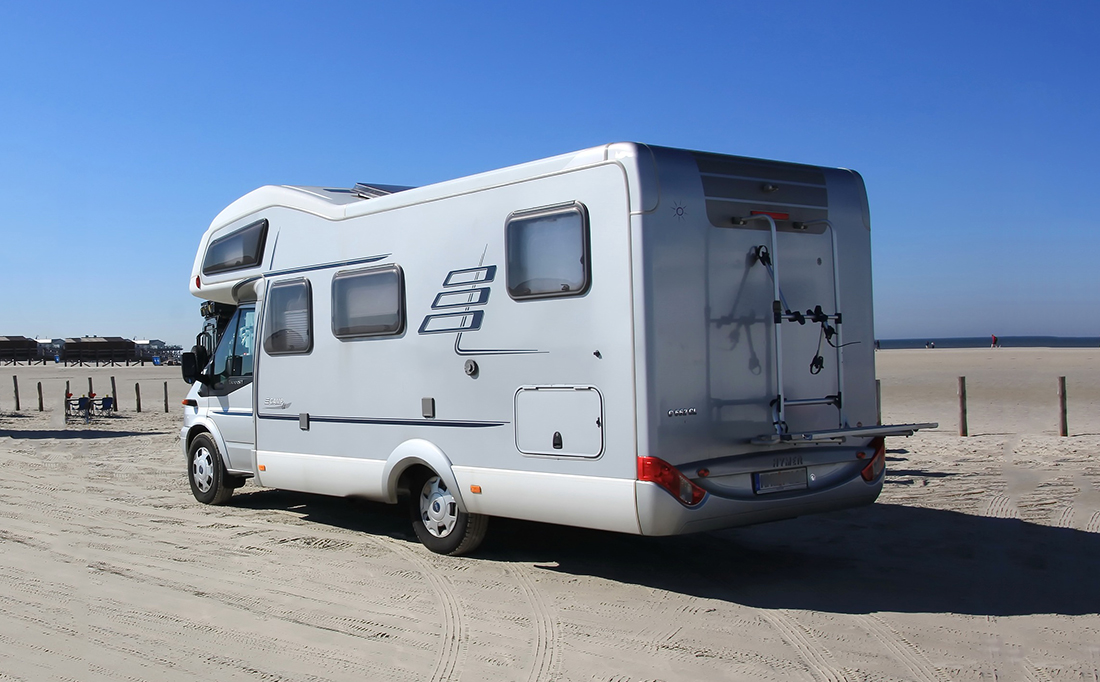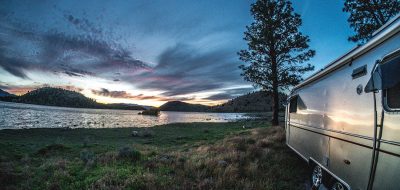Coastal camping — staying warm when the temperature dips.
Camping near the ocean has its obvious perks. You’re close to the surf. You can take those long strolls on the sand with that special someone that you’ve always imagined. The views are usually spectacular, regardless of whether you’re enjoying the sunrise or sunset over the ocean. And if you’re a surfer, angler, swimmer or kayaker, you’re just steps away from fun in the water.
But coastal camping also has its drawbacks. Even during the summer, salt spray from the ocean and the frequent presence of a marine fog layer can often make coastal camping a lot wetter and colder than you may have anticipated. So let’s go over some helpful pro tips for staying warm and dry when camping on the coast.

Motorhomes line the beach on a coastal campground. Photo: Paulbr75/Pixabay
Pro Tip #1: Put Things Up Overnight
When you roll into a new campsite, the tendency is to set everything up so that you only have to do it once. This way you aren’t constantly setting up and breaking down every day if you’re camping in one place for multiple days at a time. However, when it comes to coastal camping, it’s reasonable to expect that everything you leave outside overnight is going to be pretty wet in the morning. That includes chairs, tablecloths, lanterns and any other outdoor items you typically set up.
While it’s certainly less convenient, putting most of your outdoor items up at night will keep things drier and make it more comfortable for you to enjoy your time on the coast. When you want to take your cup of coffee outside to enjoy the sunrise from the comfort of your camp chair in the morning, you’ll be glad you put the chair up so that it’s nice and dry and you probably will barely notice the extra 60 seconds it takes for you to grab the chair out from wherever you stored it overnight.
Pro Tip #2: Screen in a Porch Area
This pro tip is a good one for full-time RVers as well, but screening in a porch area under your RV’s awning is a great way to stay warm and dry while coastal camping. There are a lot of useful tips for screening the area under your awning online, but an option is to go with the Carefree Buena Vista Room available at Camping World, which fits traditional manual and 12-volt awnings with vertical arms. Also effective is Carefree Vacation’r Room (pictured).
Screening in a porch area under your RV’s awning will give you an outdoor area free from moisture and protected from the wind. It will also allow you to set up your typical outdoor items, such as camping chairs, a table and lanterns, without having to put them up before you head to bed each night.

A camping trailer on a windy day. Photo: StockSnap/Pixabay
Pro Tip #3: Create a Wind Screen
The wind coming off the ocean will cool down your campsite quickly. The easiest way to keep your spot protected from the wind is to consider how you position your RV when you first pull in. If you’re careful, you can actually use your RV as a windscreen by positioning the driver’s side into the wind. This will allow your RV to serve as a windscreen and also reduce the effect of the wind on your awning if you decide to put it out for sun and/or rain protection.
If you aren’t able to use your RV to create a windscreen because of the way the campground is set up, you still have options. You can use a large tarp or sheet to create a windbreak. Position the tarp or sheet so that it blocks the primary direction the wind is coming from.
You may have to get creative with where and how you string up this option (i.e. trees, rocks, tie-down points on your RV, the ladder, etc.), but it will ultimately give you more respite from high winds on the coast than doing nothing at all. The key is to get the tarp secured to at least four points while keeping it as close to the ground as possible. The higher off the ground it is the more it will allow wind underneath through, which will ultimately cool off your outdoor camping space. Some companies make windscreens expressly for beach outings.

Photo: Geralt/Pixabay
Pro Tip #4: Grab An Outdoor Space Heater
We recognize that you’re probably attracted to coastal camping precisely because you want to be outside enjoying time on the beach and the scenery looking out over the ocean. While staying inside the heated comfort of your RV is a surefire way to stay warm and dry while coastal camping, it kind of defeats the purpose of getting away to an oceanfront location.
So, instead of driving all the way to the coast just to sit inside your RV the whole time, grab an outdoor space heater to keep you warm when you want to sit outside later into the evening. Something like this Portable Steel Propane Outdoor Fire Pit will keep you warm outdoors without costing you an arm and a leg. If you plan to start a fire at your campsite, observe basic safety practices.

Enjoying views of the surf under a comfy jacket. Photo: cocoparisienne/Pixabay
Pro Tip #5: Bring Extra Clothes and Dress in Layers
Aside from all the other nifty tricks we’ve mentioned above, our last pro tip comes back to just keeping your own body warm and dry. Layers are the most effective way to stay warm and make sure the coastal chill doesn’t penetrate all the way to skin level. If you don’t have a quality rain jacket, preparing for your coastal camping trip is a great excuse to buy one. If you’re in the market, check out the Thunder-Cloud II rain jacket from Ultimate Terrain. In the worst-case scenario, you can always keep a few emergency ponchos on board as well.
When things get wet while coastal camping, your best bet is to change out of wet gear and into something dry as soon as possible. Staying in wet gear can quickly lead to an uncomfortable coastal camping experience. You can also be more prepared by bringing extra towels along. You’ll most likely find yourself drying things off more than you might anticipate, so it’s really nice to have a truly dry towel available when you really need it for yourself!

Parking at the beach and preparing for camping fun. Photo: Schlappohr/Pixabay
Where’s Your Next Coastal Camping Trip?
We hope you’ve found these pro tips for staying warm and dry while coastal camping useful, and we’d love to know if you have any additional tips for our readers that we didn’t mention above. We’d also like to hear where you’re going to be camping next! As the seasons change, it’s time to get out and start camping again. Let us know where you’re heading along the coast this spring, summer, or fall!








